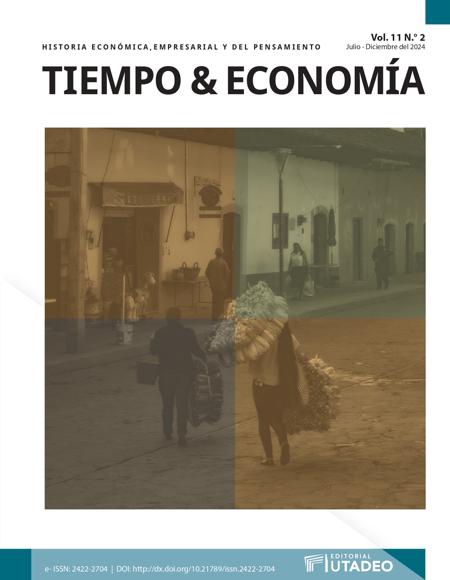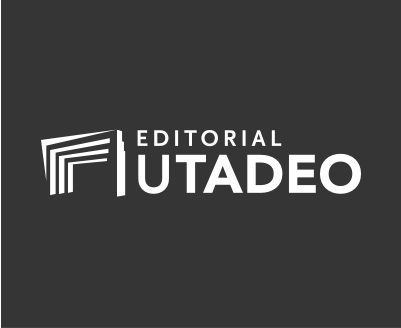
Esta obra está bajo una licencia internacional Creative Commons Atribución-NoComercial-CompartirIgual 4.0.
Esta obra está bajo una licencia internacional Creative Commons Atribución-NoComercial-CompartirIgual 4.0.
Resumen
Hispanic American economic history has puzzled scholars due to its particularities. The region is known for its abundance of natural resources and land, but since its independence, it has not been able to transfer those endowments into sustainable modern economic growth. Some researchers affirm that “we are still far away to understand the causes of the slow growth of Latin America”. This essay is a literature review, which assesses the debates around the question of why Hispanic America did not have a financial revolution after its independence? It also provides a nuanced explanation of the immaturity of the Hispanic American financial markets, the persistence of the Censo Eclesiastico, a type of loan/mortgage widely used as a source of credit during the colonial era, which was only prohibited in the mid-nineteenth century. This type of loans had some unique characteristics, like rent-seeking and close interpersonal relationships between providers and takers within the capital market of the region at that time. Those characteristics could explain the lack of interest of the elites in the establishment of modern financial institutions. The persistence of the censos caused the immaturity of the capital market in Hispanic America. However, more studies are needed it to assert this with confidence and this essay is a call for further studies on the matter.
Citas
Abulafia, D. (1998). The impact of Italian banking in the late Middle Ages and the Renaissance, 1300-1500. In Teichova, A., Hetenryk, G. and Ziegler, D. (Eds.), Banking, Trade and Industry: Europe, America and Asia from the Thirteenth to the Twentieth Century. (pp. 17-35). Cambridge University Press.
Acemoglu, D., Johnson, S. &Robinson, J. (2001). The Colonial Origins of Comparative Development: An Empirical Investigation. The American Economic Review 91(5), 1369-1401. https://doi.org/10.1257/aer.91.5.1369
Atack, J. (2010). Financial innovations and crises: The view backwards from the Northern Rock. In The Origins and Development of Financial Markets and institutions. From the seventeenth century to the present (pp. 1-31) Cambridge University Press. https://doi.org/10.1017/CBO9780511757419.002
Bates, R., Coatsworth, J. & Williamson J. (2007). Lost Decades: Postindependence Performance in Latin America and Africa. The Journal of Economic History 67(4), 917943. https://doi.org/10.1017/S0022050707000447.
Bauer, A. (1983). The Church in the Economy of Spanish America: Censos and Depósitos in the Eighteenth and Nineteenth Centuries. The Hispanic American Historical Review 63(4), 707-733. https://doi.org/10.1215/00182168-63.4.707
Bordo, M. & Cortés-Conde, R. (2001). Transferring Wealth and Power from the Old to the New World. Monetary and Fiscal Institutions in the 17th through the 19th Centuries. Cambridge University Press. https://doi.org/10.1017/CBO9780511664793
Broadberry, S. (1998). How Did the United States and Germany Overtake Britain? A Sectoral Analysis of Comparative Productivity Levels, 1870-1990. The Journal of Economic History, vol. 58(2), 375-407. https://doi.org/10.1017/S0022050700020556
Buchnea, E. (2020). Bridges and Bonds: The Role of British Merchant Bank Intermediaries in Latin American Trade and Finance Networks, 1825-1850. Enterprise & Society 21(2), 453-493. https://doi.org/10.1017/eso.2019.37
Bulmer-Thomas, V. (2014). The Economic History of Latin America since Independence. Cambridge University Press. https://doi.org/10.1017/CBO9781139208710
Bulmer-Tomas, V., Coasthworth, J.& Cortés-Conde, R. (2006). The Cambridge Economic History of Latin America, vol.I. Cambridge University Press. https://doi.org/10.1017/CHOL9780521812900
Calomiris, C. & Haber, S. (2014). Fragile by Design. The Political Origins of Banking Crises and Scarce Credit. Princeton University Press. https://doi.org/10.1515/9781400849925
Cardenas, M. (2010). State Capacity in Latin America. Economía 10(2), 1-45. https://doi.org/10.1353/eco.2010.0003
Cascavita-Mora, J. (2013). La desamortización en Colombia 1861-1865: Primeros Años, el caso de los Censos. [Bachelor’s degree dissertation, Universidad Nacional de Colombia].
Cascavita-Mora, J. (2016). El crédito colonial. Desempeño del crédito eclesiástico –los censos– desde una perspectiva local. Santafé, 1760-1770. [Master’s degree dissertation, Universidad de los Andes].
Colmenares, G. (1974). Censos y capellanías: formas de crédito en una economía agrícola. Cuadernos Americanos Colombianos 2, 125-143.
Cortés-Conde, R. (1999). The Origins of banking in Argentina. In Sylla, R. Tilly, R. & Tortilla, G. (Eds.), The State, The financial System and Economic Modernization (224-270). Cambridge University Press.
De la Escosura, P. (2009). Lost Decades? Economic Performance in Post-Independence Latin America. Journal of Latin American Studies 41, 279-307. https://doi.org/10.1017/S0022216X09005574
Del Valle Pavón, G. (2020). Estrategias de inversión de los mercaderes de México: la fundación de capellanías a fines del siglo XVIII. Investigaciones de Historia Económica 16(3), 30-43. https://doi.org/10.33231/j.ihe.2020.01.001
Diekmann, K. & Westerman, F. (2012). Financial development and sectoral output growth in nineteenth-century Germany. Financial History Review 19(2), 149-174. https://doi.org/10.1017/S0968565012000066
Dincecco, M. (2015). The rise of effective states in Europe. Journal of Economic History 75(3), 901-918. https://doi.org/10.1017/S002205071500114X
Engerman, S. & Sokoloff, K. (2002). Factor Endowments, Inequality, and Paths of Development among New World Economies. Economía 3(1), 41-109. https://doi.org/10.1353/eco.2002.0013
Engerman, S. & Sokoloff, K. (2012). Economic Development in the Americas since 1500. Endowments and Instittutions. Cambridge University Press.
Ferreira, C. (1999). El crédito colonial en la provincia de Pamplona-Nueva Granada: usos del censo consignativo. Signos Históricos 1, 59-83.
Fritschy, W. (2017). Public Finance of the Dutch Republic in the 17th and 18th Centuries. In Public Finance of the Dutch Republic in Comparative Perspective. Brill. https://doi.org/10.1163/9789004341289_006
Gelderblom, O. & Jonker, J. (2011). Public Finance and Economic Growth: The Case of Holland in the Seventeenth Century. The Journal of Economic History 71(1), 1-39. https://doi.org/10.1017/S0022050711000015
Gelderblom, O. & Jonker, J. (2014). The Low Countries. In Neal, L. & Williamson, J. (Eds.), The Cambridge History of Capitalism: The Rise of Capitalism From Ancient Origins to 1848. Volume I (pp. 314-356) Cambridge University Press. https://doi.org/10.1017/CHO9781139095099.011
Gelman, J. (2009). ¿Crisis Postcolonial en las Economías sudamericanas? Los casos del Rio de la Plata y del Perú. In Nada Excepcional. El crecimiento económico de Latinoamerica y España en la primera mitad del siglo XIX. Marcial Pons, Ediciones de Historia S.A.
Granados, O. & Torres, J. (2023). Credit networks and business dynamics in a viceregal capital: Santafé de Bogotá in the age of Charles III. Financial History Review 30(3), 330-354. https://doi.org/10.1017/S0968565023000112
Haber, S. (1997). Financial Markets and Industrial Development: A Comparative Study of Governmental Regulation, Financial Innovation, and Industrial Structure in Brazil and Mexico, 1840-1930. In Haber, S. (Ed.), How Latin America Fell Behind (pp. 146-178). Stanford University Press. https://doi.org/10.1515/9781503622500-009
Haber, S. (2012). Politics and Banking Systems. In Engerman S. & Sokoloff K. (Eds.), Economic Development in the Americas since 1500. Endowments and Institutios (pp. 245-294). Cambridge University Press.
Irigoin, A. (2009). Gresham on Horseback: The Monetary Roots Spanish American Political Frag-mentation in the Nineteenth Century. Economic History Review 62(3), 551-575. https://doi.org/10.1111/j.1468-0289.2008.00430.x
Jaramillo, J., Meisel, A. & Urrutia, M. (2001). Continuities and Discontinuities in the Fiscal and Monetary Institutions of New Granada, 1783-1850. In Bordo, M. & Cortés-Conde, R. (Eds.), Transferring Wealth and Power from the Old to the New World. Monetary and Fiscal Institutions in the 17th through the 19th Centuries (pp. 424-452). Cambridge University Press. https://doi.org/10.1017/CBO9780511664793.012
Johnson, N. & Koyama, M. (2017). States and economic growth: capacity and constraints. Explorations in Economic History 64, 1-20. https://doi.org/10.1016/j.eeh.2016.11.002
Knowlton, R. (1969). Expropriation of Church Property in Nineteenth-Century Mexico and Colombia: A Comparison. The Americas 25(4), 387-401. https://doi.org/10.2307/980320
Lavrin, A. (1998). Cofradías Novohispanas: Economías material y espiritual. In Martinez, P., Wobeser, G. & Muñoz, J. (Eds.), Cofradías, Capellanías y Obras Pías en la America Colonial (49-64). UNAM.
Llorca-Jaña, M. (2012). The Economic Activities of a Global Merchant-Banker in Chile: Huth & Co. of London, 1820s-1850s. Historia 45(2), 399-432. https://doi.org/10.4067/S0717-71942012000200002
López Martinez, A. (1989). La Iglesia y los censos. Estudio de los títulos de propiedad de los censos del monasterio de Regina Coeli de Sanlúcar de Barrameda. In IV Congreso de profesores-investigadores: Comunicaciones (67-81). Hésperides.
López-Bejarano, P. (2015). Un Estado a crédito Deudas y configuración estatal de la Nueva Granada en la primera mitad del siglo XIX. Pontificia Universidad Javeriana. https://doi.org/10.2307/j.ctv893gs1
Maddison Project Database (2020). Maddison style estimates of the evolution of the world economy. A new 2020 update.
Marichal, C. & Carmagnani, M. (2001). Mexico: From Colonial Fiscal Regime to Liberal Financial Order. In Bordo, M. & Cortés-Conde, R. (Eds.), Transferring Wealth and Power from the Old to the New World. Monetary and Fiscal Institutions in the 17th through the 19th Centuries (259-283). Cambridge University Press.
Marichal, C. & Llopis, E. (2009). Nada Excepcional. El crecimiento económico de Latinoamérica y España en la primera mitad del siglo XIX. Marcial Pons Ediciones de Historia.
Marichal, C. (1989). A Century of Debt Crises. In Latin America. From Independence to the Great Depression, 1830-1930. Princeton University Press.
Marichal, C. (2006). Money, Taxes, and Finance. In Bulmer-Thomas, V., Coatsworth, J. & Cortés-Conde, R. (Eds.), The Cambridge Economic History of Latin America, Vol I (423-460) Cambridge University Press. https://doi.org/10.1017/CHOL9780521812894.014
Marichal, C. (2021). El Nacimiento de la Banca en América Latina. Finanzas y política en el siglo XIX. El Colegio de México/Centro de Estudios Históricos. https://doi.org/10.2307/jj.1823142
Neal, L. (2015). A concise history of international finance: From Babylon to Bernanke. Cambridge University Press. https://doi.org/10.1017/CBO9781139524858
North, D. (1990). Institutions, Institutional Change, and Economic Performance. Cambridge University Press. https://doi.org/10.1017/CBO9780511808678
Ocampo, J. & Bertola, L. (2012). The Economic Development of Latin American Since Independence. Oxford University Press. https://doi.org/10.1093/acprof:oso/9780199662135.001.0001
Ocampo, J. & Ros, J. (2011). The Oxford Handbook of Latin American Economics. Oxford University Press. https://doi.org/10.1093/oxfordhb/9780199571048.001.0001
Ortiz, A. (2016). Antececentes del Credito en Colombia. Tiempo & Economia 3(2), 9-31. https://doi.org/10.21789/24222704.1127
Przeworski, A. & Curvale, C. (2008). Does Politics Explain the Economic Gap between the United States and Latin America? In Fukuyama, F. (Ed.), Falling behind: Explaining the Development Gap between Latin America and the United States. Oxford University Press.
Quinn, S. & Roberds, W. (2003). An economic explanation of the early Bank of Amsterdam, debasement, bills of exchange and the emergence of the first central bank. In Bordo, M., Taylor, A. & Williamson, J. (Eds.), Globalization in Historical Perspective (32-70). University of Chicago Press.
Quiroz, A. (1993). Domestic and Foreign Finance in Modern Peru, 1850-1950: Financing Visions of Development. Pittsburg University Press.
Robinson, J. (2008). Latin American Equilibrium. In Fukuyama, F. (Ed.), Falling behind: Explaining the Development Gap between Latin America and the United States. Oxford University Press.
Rousseau, P. & Sylla, R. (2003). Financial Systems, Economic Growth, and Globalisation. In Bordo, M., Taylor, A. & Williamson, J. (Eds.), Globalization in Historical Perspective (373-415). University of Chicago Press. https://doi.org/10.7208/chicago/9780226065991.003.0009
Sempat Assadourian, C. (1982). El Sistema de la Economía Colonial. Mercado Interno, Regiones y Espacio Económico. IEP Ediciones.
Sokoloff, K. & Zolt, E. (2006). Inequality and Taxation, Evidence from the Americas on How Inequality May Influence Tax Institutions. Tax Law Review 59(2)2, 201- 276.
Sylla, R. (2002). Financial Systems and Economic Modernization. Journal of Economic History 62 (2), 277-292. https://doi.org/10.1017/S0022050702000505
Sylla, R. (2010). Comparing the UK and US Financial Systems, 1790-1830. In Atack, J. & Neal, L. (Eds.), The Origins and Development of Financial Markets and institutions. From the seventeenth century to the present (209-240). Cambridge University Press. https://doi.org/10.1017/CBO9780511757419.008
Tilly, C. (1990), Coertion, Capital and European States, AD, 990-1990. Basil Backwell.
Torres, J. (2014). Tasas de interés y desempeño económico: el crédito comercial en Santafé de Bogotá, 1760-1810. América Latina En La Historia Económica, 21(3), 9–45. https://doi.org/10.18232/alhe.v21i3.577
Uribe-Castro, M. (2018). Expropriation of Church wealth and political conflict in 19th century Colombia. Second Annual LSE-Stanford-Universidad de los Andes: Papers on Long-Run Development in Latin America, Working Paper. https://www.lse.ac.uk/lacc/publications/PDFs/UribeCastro-ChurchConflictColombia-0118.pdf
Wobeser, G. (2010). El crédito eclesiástico en la Nueva España, siglo XVIII. FCE.
Wobeser, G. (2011). La actividad crediticia de instituciones Eclesiásticas de la Ciudad de Mexico, Siglo XVIII. Estudios de Historia Novohispanos 44, 113-138. https://doi.org/10.22201/iih.24486922e.2011.044.24004
Wright, G. (1990). The Origins of American Industrial Success, 1879-1940. The American Economic Review 80(4), 651-668.
Zegarra, L. (2006). Institutions, Economic Development and Early Banking in Latin America, 1850 1930. [Doctoral dissertation, University of California].
Zegarra, L. (2014). Bank laws, economic growth and early banking in Latin America: 1840-1920. Explorations in Economic History 53, 101-119. https://doi.org/10.1016/j.eeh.2014.01.001
Zendejas, J. (2020). Explaining Latin America’s Persistent Defaults: An Analysis of the Debtor-Creditor Relations in London, 1822-1914. Financial History Review 27(3), 319-339. https://doi.org/10.1017/S0968565020000190

 PDF (English)
PDF (English)
 FLIP
FLIP












